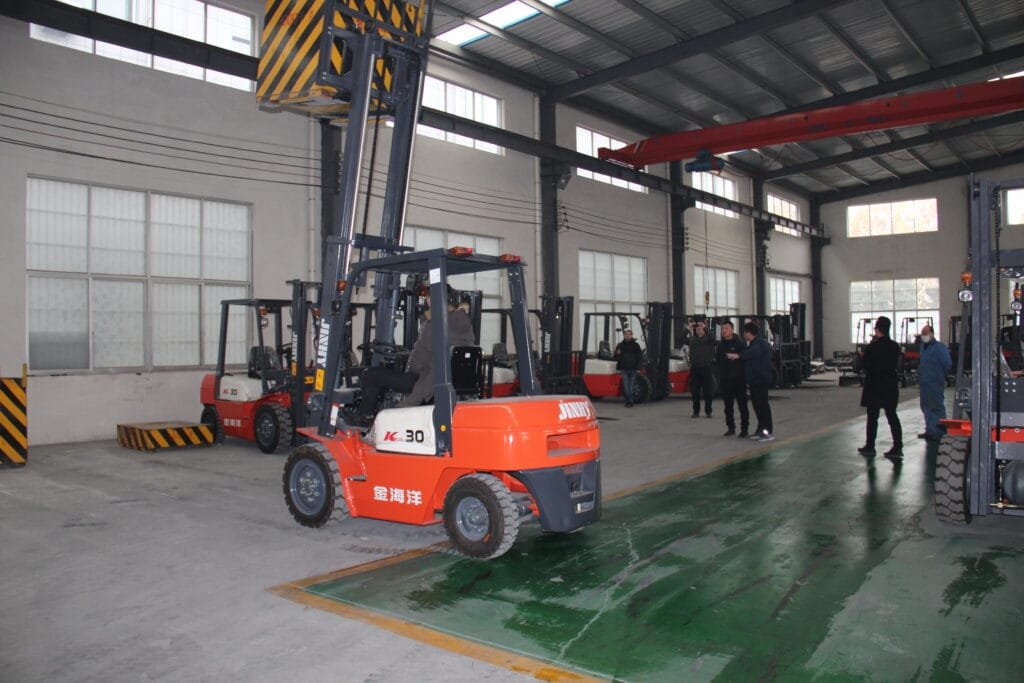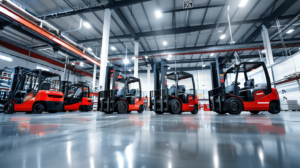Introduction
China has established itself as a powerhouse in manufacturing forklifts, especially in the electric segment. With brands like Heli, Hangcha, BYD, Lonking, EP, and more marked internationally, Chinese forklifts often deliver significant cost advantages—typically 20–40% cheaper than Western equivalents—while integrating advanced battery technologies and customization options.
An informed purchasing approach can help international buyers sidestep common pitfalls and secure long-term value. This guide will highlight key considerations, from identifying needs to sealing contracts, ensuring you make a strategic, confident decision.

1. Understand Your Operational Requirements
Before browsing suppliers, define your operational needs:
- Load Capacity & Lift Height: Choose a model rated with a safety margin above your max load and stacking height.
- Terrain & Environment: Indoor applications favor electric forklifts; rugged terrains may require diesel or all-wheel drive rough-terrain units.
- Duty Cycle & Usage Patterns: Heavy daily use may justify investing in IC units with swift refueling; intermittent indoor operations often benefit from electric models with lower emissions and maintenance needs .
Defining these parameters up front ensures compatibility and future reliability.
2. Research and Compare Top Chinese Brands
Here’s an overview of leading Chinese forklift brands:
- Anhui Heli – China’s #1 and globally 7th largest forklift producer, with in-house manufacturing and strong quality control.
- Hangcha – The 8th largest global forklift maker, offering extensive product lines and a 300+ dealer/service network internationally.
- BYD – Focused on electric forklifts and lithium battery tech, ideal for emission-sensitive environments.
- Lonking – Offers both IC and electric forklifts with competitive pricing.
- EP Equipment – Known for warehouse-focused electric models with lithium-ion integration.
- Small/Niche Brands: Nicosail, Meenyon, Maximal, UN—provide tailored customization and may offer more flexible service for specific use-cases.
For international buyers, focus on brands with proven export capacity, strong global service presence, and positive customer feedback.

3. Prioritize Certifications & Quality Standards
Safety and compliance are paramount:
- Certificates to look for: CE, ISO9001, ISO14001, EPA, ANSI—or local equivalents.
- Verify with official documentation and cross-check serial numbers.
- This ensures safety, liability protection, and adherence to import regulations.
4. Evaluate After-Sales Support & Parts Availability
Reliable service networks and parts availability are vital:
- Brands like Hangcha and Heli have global dealer networks; smaller brands may rely on local distributors.
- Platforms like TVH can assist with sourcing parts .
- Importers on forums stress: “With good after‑sales service and support, it is definitely a viable and profitable business… Chinese trucks… are decent working machines… suitable for most day to day jobs.”
- Discuss warranties, parts lead times, and whether local stocking is available.
5. Consider Total Cost of Ownership (TCO)
Look beyond the sticker price:
- Upfront costs: equipment, shipping, duties, installation.
- Operating costs: fuel or electricity, parts, and maintenance.
- Electric forklifts: initial higher price but lower running costs; consider battery replacement cycles.
- Downtime risk: longer repair and shipment times increase maintenance costs.
- Depreciation: used vs. new forklifts? Used offers savings but verify history and refurb conditions .
Understanding complete lifecycle costs reveals true value.

6. Verify Manufacturing Capacity & Customization Options
- Ensure suppliers can meet volume demands with quality consistency .
- Ask about customization: specialty masts, cabins, attachments—especially critical for niche applications.
- Small brands may offer bespoke services but ensure proper quality assurance.
7. Inspect Reliability & Performance
Gauge build quality and long-term reliability:
- Inquire about materials used and fatigue data.
- Seek operational references or trial runs.
- Forum insight: Heli controls component quality and is considered more reliable; Hangcha tends to assemble with sourced parts but uses reputable suppliers like Zapi and Danaher.
8. Navigate Shipping & Logistics
A seamless logistics strategy is essential:
- Choose Incoterms wisely (e.g., FOB, CFR, CIF).
- Coordinate with freight forwarders who handle customs, port fees, insurance, and bonded warehouse procedures.
- On forums: “Your forwarder should do all of this… you won’t be hit with surprise charges” .
- Plan for customs clearance processes based on your destination’s import norms.

9. Negotiate Contracts & Payment Terms
Secure transparent and protective agreements:
- Use pro forma invoices detailing price, delivery schedule, payment installments.
- Negotiate deposit amounts, LC terms, and penalties for delays.
- Outline warranty durations, part guarantees, training terms, and responsibilities clearly.
10. Conduct Quality Audits & Pre‑Shipment Inspections
Quality inspections prevent surprises:
- Engage third-party inspectors to verify the exact specs against your order.
- Have them test drive units, inspect paint finishes, label compliance, and documentation completeness.
- These steps mitigate risks and ensure product accuracy.
11. Prioritize Aftercare & Training
Operational readiness is vital:
- Include operator training for safety and efficient use.
- Set clear maintenance schedules and document procedures.
- Ensure maintenance training is included—critical especially for electric units.
12. Soft-Landing Strategy
Scale responsibly:
- Begin with one or two pilot units before bulk purchases.
- Monitor performance: parts usage, downtime, operating feedback.
- Adjust terms, reorder quantities, or switch providers based on outcomes.

Conclusion
Careful planning turns a budget-friendly purchase into long-term value. By understanding operational needs, vetting brands, verifying compliance, securing robust contracts, and ensuring proper logistics—and aftercare—you can confidently purchase a Chinese forklift and avoid buyer’s remorse.
FAQs
1. Can Chinese forklifts match Western quality?
Yes—top brands like Heli and Hangcha offer comparable quality at lower prices, especially in electric models.
2. What lead times should buyers expect?
Typically 4–8 weeks from ordering to delivery, depending on production, shipping, and customs.
3. How robust is after-sales support?
Large brands provide solid global networks; smaller brands may still offer support but require careful vetting .
4. Local distributor vs. direct import—what’s better?
Distributors offer smoother logistics, local parts, and technical support. Direct import can save cost but increases complexity.
5. Electric vs. IC—which is cost-effective?
Indoor operations benefit from electric (lower maintenance, zero emissions). IC is better for heavy outdoor duty with quicker turnaround.
Let me know if you’d like deeper comparisons of brands, real-world performance data, or assistance with supplier sourcing and logistics strategies!




